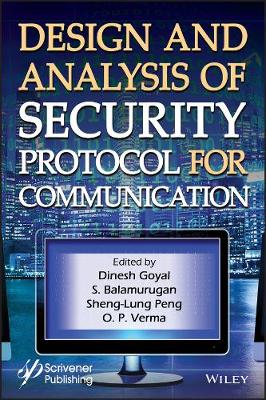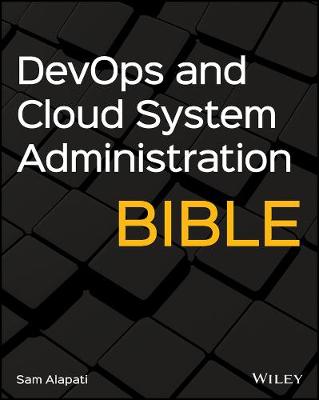Design and Analysis of Security Protocol for Communication
 -15%
portes grátis
-15%
portes grátis
Design and Analysis of Security Protocol for Communication
Balamurugan, S.; Verma, O. P.; Goyal, Dinesh; Peng, Sheng-Lung
John Wiley & Sons Inc
03/2020
368
Dura
Inglês
9781119555643
15 a 20 dias
688
Descrição não disponível.
Preface xiii
1 History and Generations of Security Protocols 1
Bright Keswani, Poonam Keswani and Rakhi Purohit
1.1 Introduction 2
1.2 Network Security 2
1.3 Historical Background of Network Security and Network Timeline 4
1.4 Internet Architecture and Security Aspects 5
1.4.1 IPv4 and IPv6 Architecture 6
1.4.1.1 Structure of IPv4 6
1.4.1.2 IPv6 Architecture 7
1.4.2 Attack Through IPv4 8
1.4.2.1 Internet Attacks Common Methods 8
1.4.2.2 Internet Security Technology 10
1.4.3 IPv6 IP Security Issues 11
1.5 Different Aspects of Security of the Network 12
1.6 Evolution of Security Protocols for Network 13
1.6.1 Understanding the Key Components of Network Security 13
1.6.2 A Deep Defense Strategy 14
1.6.3 How Does the Next Generation Network Security System Work Best 15
1.7 Network Security Protocols 17
1.7.1 Application Layer 17
1.7.1.1 Good Privacy (PGP) 17
1.7.1.2 Email/Multipurpose Security (S/MIME) 18
1.7.1.3 HTTP Secure (S-HTTP) 18
1.7.1.4 Hypertext Transfer Protocol (HTTPS) in Secure Sockets Layer 19
1.7.1.5 Secure E-Commerce (SET) 19
1.7.1.6 Kerberos 19
1.7.2 Transport Layer 20
1.7.2.1 Secure Sockets Layer (SSL) 20
1.7.2.2 Transport Layer Security (TLS) 21
1.7.3 Network Layer 21
1.7.3.1 Internet Protocol Security (IPSec) 22
1.7.3.2 Virtual Private Network (VPN) 23
1.7.4 Data Link Layer 24
1.7.4.1 Point-to-Point Protocol (PPP) 24
1.7.4.2 Remote Authentication User Service (RADIO) 24
1.7.4.3 Terminal System Access Control Access Control Equipment (TACACS +) 25
1.8 Current Evolution of Red Security 25
1.8.1 Hardware Development 25
1.8.2 Software Development 27
1.9 Future Security Trends 27
References 27
2 Evolution of Information Security Algorithms 29
Anurag Jagetiya and C. Rama Krishna
2.1 Introduction to Conventional Encryption 30
2.2 Classical Encryption Techniques 31
2.2.1 Substitution Based 32
2.2.1.1 Caesar Cipher 32
2.2.1.2 Monoalphabetic Cipher 32
2.2.1.3 Playfair Cipher 33
2.2.1.4 Polyalphabetic Cipher 35
2.2.2 Transposition Based 36
2.2.2.1 Simple Columnar 36
2.2.2.2 Rail Fence Cipher 37
2.3 Evolutions of Modern Security Techniques 38
2.3.1 Stream Cipher Algorithms 38
2.3.1.1 One Time Pad (OTP) 40
2.3.1.2 RC-4 41
2.3.1.3 A5/1 43
2.3.2 Block Cipher Algorithms 44
2.3.2.1 Feistel Cipher Structure 46
2.3.2.2 Data Encryption Standard (DES) 48
2.3.2.3 Triple Data Encryption Standard (TDES) 56
2.3.2.4 International Data Encryption Algorithm (IDEA) 58
2.3.2.5 Blowfish 60
2.3.2.6 CAST-128 62
2.4 Conclusion 66
References 67
Practice Set 67
Review Questions and Exercises 70
3 Philosophy of Security by Cryptostakes Schemes 79
Hemant Kumar Saini
3.1 Philosophy of Public Key Cryptosystems (p-k Cryptography) 79
3.2 RSA Algorithm 81
3.3 Security Analysis of RSA 84
3.4 Exponentiation in Modular Arithmetic 85
3.5 Distribution of Public Keys 87
3.6 Distribution of Secret Keys Using Public Key Cryptosystems 89
3.7 Discrete Logarithms 91
3.8 Diffie-Hellman Key Exchange 91
3.9 Review Exercise 93
References 94
4 Zero-Share Key Management for Secure Communication Across a Channel 95
P. R. Mahalingam and K. A. Fasila
4.1 Introduction 95
4.2 Background 96
4.3 Zero-Share Key Management System 98
4.4 Simulation 100
4.5 Complexity and Analysis 103
4.6 Conclusion and Future Trends 106
References 107
5 Soft Computing-Based Intrusion Detection System With Reduced False Positive Rate 109
Dharmendra G. Bhatti and Paresh V. Virparia
5.1 Introduction 109
5.1.1 Soft Computing for Intrusion Detection 111
5.1.2 False Positive 112
5.1.3 Reasons of False Positive 113
5.2 Existing Technology and Its Review 115
5.3 Research Design 118
5.3.1 Conceptual Framework 118
5.3.2 Preprocessing Module 121
5.3.3 Alert Monitoring Module 123
5.4 Results With Implications 124
5.4.1 Preprocessing Module Benchmark 126
5.4.2 Alert Monitoring Module Benchmark 129
5.4.3 Overall Benchmark 130
5.4.4 Test Bed Network Benchmark 131
5.5 Future Research and Conclusion 133
References 135
6 Recursively Paired Arithmetic Technique (RPAT): An FPGA-Based Block Cipher Simulation and Its Cryptanalysis 141
Rajdeep Chakraborty and J.K. Mandal
6.1 Introduction 141
6.2 Recursively Paired Arithmetic Technique (RPAT) 142
6.2.1 An Example of RPAT 144
6.2.2 Options of RPAT 145
6.2.3 Session Key Generation 146
6.3 Implementation and Simulation 147
6.4 Cryptanalysis 150
6.5 Simulation Based Results 152
6.6 Applications 152
6.7 Conclusion 153
Acknowledgment 153
References 153
7 Security Protocol for Multimedia Streaming 155
N. Brindha, S. Deepa and S. Balamurugan
7.1 Introduction 156
7.1.1 Significance of Video Streaming 156
7.2 Existing Technology and Its Review 162
7.3 Methodology and Research Design 166
7.4 Findings 167
7.5 Future Research and Conclusion 169
References 169
8 Nature Inspired Approach for Intrusion Detection Systems 171
Mohd Shahid Husain
8.1 Introduction 171
8.1.1 Types of Intrusion Detection Systems 172
8.2 Approaches Used for Intrusion Detection Systems 173
8.2.1 Intrusion Detection and Prevention Systems 173
8.2.2 Performance Criteria of Intrusion Detection Systems 174
8.3 Intrusion Detection Tools 175
8.4 Use of Machine Learning to Build Dynamic IDS/IPS 176
8.5 Bio-Inspired Approaches for IDS 178
8.6 Conclusion 179
References 181
9 The Socio-Behavioral Cipher Technique 183
Harshit Bhatia, Rahul Johari and Kalpana Gupta
9.1 Introduction 183
9.2 Existing Technology 184
9.3 Methodology 186
9.3.1 Key Arrangement 187
9.3.2 Key Selection 188
9.3.3 Mathematical Operations 189
9.3.4 Algorithm 191
9.3.5 Encryption Operation 192
9.3.6 Decryption Operation 193
9.3.7 Mathematical Modeling 201
9.4 Conclusion: Future Scope and Limitations 205
References 208
10 Intrusion Detection Strategies in Smart Grid 211
P. Ponmurugan, C. Venkatesh, M. Divya Priyadharshini and S. Balamurugan
10.1 Introduction 212
10.2 Role of Smart Grid 212
10.3 Technical Challenges Involved in Smart Grid 213
10.4 Intrusion Detection System 216
10.5 General Architecture of Intrusion Detection System 217
10.6 Basic Terms in IDS 218
10.7 Capabilities of IDS 219
10.8 Benefits of Intrusion Detection Systems 219
10.9 Types of IDS 220
10.10 IDS in a Smart Grid Environment 222
10.10.1 Smart Meter 223
10.10.2 Metering Module 223
10.10.3 Central Access Control 224
10.10.4 Smart Data Collector 224
10.10.5 Energy Distribution System 225
10.10.6 SCADA Controller 225
10.11 Security Issues of Cyber-Physical Smart Grid 225
10.12 Protecting Smart Grid From Cyber Vulnerabilities 227
10.13 Security Issues for Future Smart Grid 229
10.14 Conclusion 230
References 230
11 Security Protocol for Cloud-Based Communication 235
R. Suganya and S. Sujatha
11.1 Introduction 236
11.2 Existing Technology and Its Review 237
11.3 Methodology (To Overcome the Drawbacks of Existing Protocols) 238
11.4 Findings: Policy Monitoring Techniques 238
11.5 Future Research and Conclusion 240
Reference 241
12 Security Protocols for Mobile Communications 243
Divya Priyadharshini M., Divya R., Ponmurugan P. and Balamurugan S.
12.1 Introduction 244
12.2 Evolution of Mobile Communications 246
12.3 Global System for Mobiles (GSM) 248
12.4 Universal Mobile Telecommunications System (UMTS) 250
12.5 Long Term Evolution (LTE) 251
12.6 5G Wireless Systems 254
12.7 LoRA 257
12.8 5G Integrated With LoRA 258
12.9 Physical Layer Security and RFID Authentication 259
12.10 Conclusion 259
References 260
13 Use of Machine Learning in Design of Security Protocols 265
M. Sundaresan and D. Boopathy
13.1 Introduction 266
13.2 Review of Related Literature 269
13.3 Joint and Offensive Kinetic Execution Resolver 271
13.3.1 Design of JOKER Protocol 273
13.3.2 Procedure 276
13.3.3 Procedure 278
13.3.4 Simulation Details and Parameters 279
13.3.4.1 Packet Delivering Ratio Calculation 279
13.3.4.2 Packet Loss Ratio Calculation 279
13.3.4.3 Latency (Delay) Calculation 279
13.3.4.4 Throughput Calculation 280
13.4 Results and Discussion 280
13.5 Conclusion and Future Scope 283
References 283
14 Privacy and Authentication on Security Protocol for Mobile Communications 287
Brajesh Kumar Gupta "Mewadev"
14.1 Introduction 288
14.2 Mobile Communications 289
14.3 Security Protocols 291
14.4 Authentication 294
14.5 Next Generation Networking 298
14.6 Conclusion 302
References 303
15 Cloud Communication: Different Security Measures and Cryptographic Protocols for Secure Cloud Computing 305
Anjana Sangwan
15.1 Introduction 305
15.2 Need of Cloud Communication 306
15.3 Application 309
15.4 Cloud Communication Platform 310
15.5 Security Measures Provided by the Cloud 310
15.6 Achieving Security With Cloud Communications 312
15.7 Cryptographic Protocols for Secure Cloud Computing 314
15.8 Security Layer for the Transport Protocol 315
15.9 Internet Protocol Security (IPSec) 317
15.9.1 How IPsec Works 318
15.10 Kerberos 320
15.11 Wired Equivalent Privacy (WEP) 326
15.11.1 Authentication 326
15.12 WiFi Protected Access (WPA) 327
15.13 Wi-Fi Protected Access II and the Most Current Security Protocols 328
15.13.1 Wi-Fi Protected Access 329
15.13.2 Difference between WEP, WPA: Wi-Fi Security Through the Ages 329
15.14 Wired Equivalent Privacy (WEP) 329
15.15 Wi-Fi Protected Access (WPA) 330
15.16 Conclusions 330
References 331
Index 333
1 History and Generations of Security Protocols 1
Bright Keswani, Poonam Keswani and Rakhi Purohit
1.1 Introduction 2
1.2 Network Security 2
1.3 Historical Background of Network Security and Network Timeline 4
1.4 Internet Architecture and Security Aspects 5
1.4.1 IPv4 and IPv6 Architecture 6
1.4.1.1 Structure of IPv4 6
1.4.1.2 IPv6 Architecture 7
1.4.2 Attack Through IPv4 8
1.4.2.1 Internet Attacks Common Methods 8
1.4.2.2 Internet Security Technology 10
1.4.3 IPv6 IP Security Issues 11
1.5 Different Aspects of Security of the Network 12
1.6 Evolution of Security Protocols for Network 13
1.6.1 Understanding the Key Components of Network Security 13
1.6.2 A Deep Defense Strategy 14
1.6.3 How Does the Next Generation Network Security System Work Best 15
1.7 Network Security Protocols 17
1.7.1 Application Layer 17
1.7.1.1 Good Privacy (PGP) 17
1.7.1.2 Email/Multipurpose Security (S/MIME) 18
1.7.1.3 HTTP Secure (S-HTTP) 18
1.7.1.4 Hypertext Transfer Protocol (HTTPS) in Secure Sockets Layer 19
1.7.1.5 Secure E-Commerce (SET) 19
1.7.1.6 Kerberos 19
1.7.2 Transport Layer 20
1.7.2.1 Secure Sockets Layer (SSL) 20
1.7.2.2 Transport Layer Security (TLS) 21
1.7.3 Network Layer 21
1.7.3.1 Internet Protocol Security (IPSec) 22
1.7.3.2 Virtual Private Network (VPN) 23
1.7.4 Data Link Layer 24
1.7.4.1 Point-to-Point Protocol (PPP) 24
1.7.4.2 Remote Authentication User Service (RADIO) 24
1.7.4.3 Terminal System Access Control Access Control Equipment (TACACS +) 25
1.8 Current Evolution of Red Security 25
1.8.1 Hardware Development 25
1.8.2 Software Development 27
1.9 Future Security Trends 27
References 27
2 Evolution of Information Security Algorithms 29
Anurag Jagetiya and C. Rama Krishna
2.1 Introduction to Conventional Encryption 30
2.2 Classical Encryption Techniques 31
2.2.1 Substitution Based 32
2.2.1.1 Caesar Cipher 32
2.2.1.2 Monoalphabetic Cipher 32
2.2.1.3 Playfair Cipher 33
2.2.1.4 Polyalphabetic Cipher 35
2.2.2 Transposition Based 36
2.2.2.1 Simple Columnar 36
2.2.2.2 Rail Fence Cipher 37
2.3 Evolutions of Modern Security Techniques 38
2.3.1 Stream Cipher Algorithms 38
2.3.1.1 One Time Pad (OTP) 40
2.3.1.2 RC-4 41
2.3.1.3 A5/1 43
2.3.2 Block Cipher Algorithms 44
2.3.2.1 Feistel Cipher Structure 46
2.3.2.2 Data Encryption Standard (DES) 48
2.3.2.3 Triple Data Encryption Standard (TDES) 56
2.3.2.4 International Data Encryption Algorithm (IDEA) 58
2.3.2.5 Blowfish 60
2.3.2.6 CAST-128 62
2.4 Conclusion 66
References 67
Practice Set 67
Review Questions and Exercises 70
3 Philosophy of Security by Cryptostakes Schemes 79
Hemant Kumar Saini
3.1 Philosophy of Public Key Cryptosystems (p-k Cryptography) 79
3.2 RSA Algorithm 81
3.3 Security Analysis of RSA 84
3.4 Exponentiation in Modular Arithmetic 85
3.5 Distribution of Public Keys 87
3.6 Distribution of Secret Keys Using Public Key Cryptosystems 89
3.7 Discrete Logarithms 91
3.8 Diffie-Hellman Key Exchange 91
3.9 Review Exercise 93
References 94
4 Zero-Share Key Management for Secure Communication Across a Channel 95
P. R. Mahalingam and K. A. Fasila
4.1 Introduction 95
4.2 Background 96
4.3 Zero-Share Key Management System 98
4.4 Simulation 100
4.5 Complexity and Analysis 103
4.6 Conclusion and Future Trends 106
References 107
5 Soft Computing-Based Intrusion Detection System With Reduced False Positive Rate 109
Dharmendra G. Bhatti and Paresh V. Virparia
5.1 Introduction 109
5.1.1 Soft Computing for Intrusion Detection 111
5.1.2 False Positive 112
5.1.3 Reasons of False Positive 113
5.2 Existing Technology and Its Review 115
5.3 Research Design 118
5.3.1 Conceptual Framework 118
5.3.2 Preprocessing Module 121
5.3.3 Alert Monitoring Module 123
5.4 Results With Implications 124
5.4.1 Preprocessing Module Benchmark 126
5.4.2 Alert Monitoring Module Benchmark 129
5.4.3 Overall Benchmark 130
5.4.4 Test Bed Network Benchmark 131
5.5 Future Research and Conclusion 133
References 135
6 Recursively Paired Arithmetic Technique (RPAT): An FPGA-Based Block Cipher Simulation and Its Cryptanalysis 141
Rajdeep Chakraborty and J.K. Mandal
6.1 Introduction 141
6.2 Recursively Paired Arithmetic Technique (RPAT) 142
6.2.1 An Example of RPAT 144
6.2.2 Options of RPAT 145
6.2.3 Session Key Generation 146
6.3 Implementation and Simulation 147
6.4 Cryptanalysis 150
6.5 Simulation Based Results 152
6.6 Applications 152
6.7 Conclusion 153
Acknowledgment 153
References 153
7 Security Protocol for Multimedia Streaming 155
N. Brindha, S. Deepa and S. Balamurugan
7.1 Introduction 156
7.1.1 Significance of Video Streaming 156
7.2 Existing Technology and Its Review 162
7.3 Methodology and Research Design 166
7.4 Findings 167
7.5 Future Research and Conclusion 169
References 169
8 Nature Inspired Approach for Intrusion Detection Systems 171
Mohd Shahid Husain
8.1 Introduction 171
8.1.1 Types of Intrusion Detection Systems 172
8.2 Approaches Used for Intrusion Detection Systems 173
8.2.1 Intrusion Detection and Prevention Systems 173
8.2.2 Performance Criteria of Intrusion Detection Systems 174
8.3 Intrusion Detection Tools 175
8.4 Use of Machine Learning to Build Dynamic IDS/IPS 176
8.5 Bio-Inspired Approaches for IDS 178
8.6 Conclusion 179
References 181
9 The Socio-Behavioral Cipher Technique 183
Harshit Bhatia, Rahul Johari and Kalpana Gupta
9.1 Introduction 183
9.2 Existing Technology 184
9.3 Methodology 186
9.3.1 Key Arrangement 187
9.3.2 Key Selection 188
9.3.3 Mathematical Operations 189
9.3.4 Algorithm 191
9.3.5 Encryption Operation 192
9.3.6 Decryption Operation 193
9.3.7 Mathematical Modeling 201
9.4 Conclusion: Future Scope and Limitations 205
References 208
10 Intrusion Detection Strategies in Smart Grid 211
P. Ponmurugan, C. Venkatesh, M. Divya Priyadharshini and S. Balamurugan
10.1 Introduction 212
10.2 Role of Smart Grid 212
10.3 Technical Challenges Involved in Smart Grid 213
10.4 Intrusion Detection System 216
10.5 General Architecture of Intrusion Detection System 217
10.6 Basic Terms in IDS 218
10.7 Capabilities of IDS 219
10.8 Benefits of Intrusion Detection Systems 219
10.9 Types of IDS 220
10.10 IDS in a Smart Grid Environment 222
10.10.1 Smart Meter 223
10.10.2 Metering Module 223
10.10.3 Central Access Control 224
10.10.4 Smart Data Collector 224
10.10.5 Energy Distribution System 225
10.10.6 SCADA Controller 225
10.11 Security Issues of Cyber-Physical Smart Grid 225
10.12 Protecting Smart Grid From Cyber Vulnerabilities 227
10.13 Security Issues for Future Smart Grid 229
10.14 Conclusion 230
References 230
11 Security Protocol for Cloud-Based Communication 235
R. Suganya and S. Sujatha
11.1 Introduction 236
11.2 Existing Technology and Its Review 237
11.3 Methodology (To Overcome the Drawbacks of Existing Protocols) 238
11.4 Findings: Policy Monitoring Techniques 238
11.5 Future Research and Conclusion 240
Reference 241
12 Security Protocols for Mobile Communications 243
Divya Priyadharshini M., Divya R., Ponmurugan P. and Balamurugan S.
12.1 Introduction 244
12.2 Evolution of Mobile Communications 246
12.3 Global System for Mobiles (GSM) 248
12.4 Universal Mobile Telecommunications System (UMTS) 250
12.5 Long Term Evolution (LTE) 251
12.6 5G Wireless Systems 254
12.7 LoRA 257
12.8 5G Integrated With LoRA 258
12.9 Physical Layer Security and RFID Authentication 259
12.10 Conclusion 259
References 260
13 Use of Machine Learning in Design of Security Protocols 265
M. Sundaresan and D. Boopathy
13.1 Introduction 266
13.2 Review of Related Literature 269
13.3 Joint and Offensive Kinetic Execution Resolver 271
13.3.1 Design of JOKER Protocol 273
13.3.2 Procedure 276
13.3.3 Procedure 278
13.3.4 Simulation Details and Parameters 279
13.3.4.1 Packet Delivering Ratio Calculation 279
13.3.4.2 Packet Loss Ratio Calculation 279
13.3.4.3 Latency (Delay) Calculation 279
13.3.4.4 Throughput Calculation 280
13.4 Results and Discussion 280
13.5 Conclusion and Future Scope 283
References 283
14 Privacy and Authentication on Security Protocol for Mobile Communications 287
Brajesh Kumar Gupta "Mewadev"
14.1 Introduction 288
14.2 Mobile Communications 289
14.3 Security Protocols 291
14.4 Authentication 294
14.5 Next Generation Networking 298
14.6 Conclusion 302
References 303
15 Cloud Communication: Different Security Measures and Cryptographic Protocols for Secure Cloud Computing 305
Anjana Sangwan
15.1 Introduction 305
15.2 Need of Cloud Communication 306
15.3 Application 309
15.4 Cloud Communication Platform 310
15.5 Security Measures Provided by the Cloud 310
15.6 Achieving Security With Cloud Communications 312
15.7 Cryptographic Protocols for Secure Cloud Computing 314
15.8 Security Layer for the Transport Protocol 315
15.9 Internet Protocol Security (IPSec) 317
15.9.1 How IPsec Works 318
15.10 Kerberos 320
15.11 Wired Equivalent Privacy (WEP) 326
15.11.1 Authentication 326
15.12 WiFi Protected Access (WPA) 327
15.13 Wi-Fi Protected Access II and the Most Current Security Protocols 328
15.13.1 Wi-Fi Protected Access 329
15.13.2 Difference between WEP, WPA: Wi-Fi Security Through the Ages 329
15.14 Wired Equivalent Privacy (WEP) 329
15.15 Wi-Fi Protected Access (WPA) 330
15.16 Conclusions 330
References 331
Index 333
Este título pertence ao(s) assunto(s) indicados(s). Para ver outros títulos clique no assunto desejado.
protocols; analyze; communication; purpose; available; tcp; protocols; discuss; objective
Preface xiii
1 History and Generations of Security Protocols 1
Bright Keswani, Poonam Keswani and Rakhi Purohit
1.1 Introduction 2
1.2 Network Security 2
1.3 Historical Background of Network Security and Network Timeline 4
1.4 Internet Architecture and Security Aspects 5
1.4.1 IPv4 and IPv6 Architecture 6
1.4.1.1 Structure of IPv4 6
1.4.1.2 IPv6 Architecture 7
1.4.2 Attack Through IPv4 8
1.4.2.1 Internet Attacks Common Methods 8
1.4.2.2 Internet Security Technology 10
1.4.3 IPv6 IP Security Issues 11
1.5 Different Aspects of Security of the Network 12
1.6 Evolution of Security Protocols for Network 13
1.6.1 Understanding the Key Components of Network Security 13
1.6.2 A Deep Defense Strategy 14
1.6.3 How Does the Next Generation Network Security System Work Best 15
1.7 Network Security Protocols 17
1.7.1 Application Layer 17
1.7.1.1 Good Privacy (PGP) 17
1.7.1.2 Email/Multipurpose Security (S/MIME) 18
1.7.1.3 HTTP Secure (S-HTTP) 18
1.7.1.4 Hypertext Transfer Protocol (HTTPS) in Secure Sockets Layer 19
1.7.1.5 Secure E-Commerce (SET) 19
1.7.1.6 Kerberos 19
1.7.2 Transport Layer 20
1.7.2.1 Secure Sockets Layer (SSL) 20
1.7.2.2 Transport Layer Security (TLS) 21
1.7.3 Network Layer 21
1.7.3.1 Internet Protocol Security (IPSec) 22
1.7.3.2 Virtual Private Network (VPN) 23
1.7.4 Data Link Layer 24
1.7.4.1 Point-to-Point Protocol (PPP) 24
1.7.4.2 Remote Authentication User Service (RADIO) 24
1.7.4.3 Terminal System Access Control Access Control Equipment (TACACS +) 25
1.8 Current Evolution of Red Security 25
1.8.1 Hardware Development 25
1.8.2 Software Development 27
1.9 Future Security Trends 27
References 27
2 Evolution of Information Security Algorithms 29
Anurag Jagetiya and C. Rama Krishna
2.1 Introduction to Conventional Encryption 30
2.2 Classical Encryption Techniques 31
2.2.1 Substitution Based 32
2.2.1.1 Caesar Cipher 32
2.2.1.2 Monoalphabetic Cipher 32
2.2.1.3 Playfair Cipher 33
2.2.1.4 Polyalphabetic Cipher 35
2.2.2 Transposition Based 36
2.2.2.1 Simple Columnar 36
2.2.2.2 Rail Fence Cipher 37
2.3 Evolutions of Modern Security Techniques 38
2.3.1 Stream Cipher Algorithms 38
2.3.1.1 One Time Pad (OTP) 40
2.3.1.2 RC-4 41
2.3.1.3 A5/1 43
2.3.2 Block Cipher Algorithms 44
2.3.2.1 Feistel Cipher Structure 46
2.3.2.2 Data Encryption Standard (DES) 48
2.3.2.3 Triple Data Encryption Standard (TDES) 56
2.3.2.4 International Data Encryption Algorithm (IDEA) 58
2.3.2.5 Blowfish 60
2.3.2.6 CAST-128 62
2.4 Conclusion 66
References 67
Practice Set 67
Review Questions and Exercises 70
3 Philosophy of Security by Cryptostakes Schemes 79
Hemant Kumar Saini
3.1 Philosophy of Public Key Cryptosystems (p-k Cryptography) 79
3.2 RSA Algorithm 81
3.3 Security Analysis of RSA 84
3.4 Exponentiation in Modular Arithmetic 85
3.5 Distribution of Public Keys 87
3.6 Distribution of Secret Keys Using Public Key Cryptosystems 89
3.7 Discrete Logarithms 91
3.8 Diffie-Hellman Key Exchange 91
3.9 Review Exercise 93
References 94
4 Zero-Share Key Management for Secure Communication Across a Channel 95
P. R. Mahalingam and K. A. Fasila
4.1 Introduction 95
4.2 Background 96
4.3 Zero-Share Key Management System 98
4.4 Simulation 100
4.5 Complexity and Analysis 103
4.6 Conclusion and Future Trends 106
References 107
5 Soft Computing-Based Intrusion Detection System With Reduced False Positive Rate 109
Dharmendra G. Bhatti and Paresh V. Virparia
5.1 Introduction 109
5.1.1 Soft Computing for Intrusion Detection 111
5.1.2 False Positive 112
5.1.3 Reasons of False Positive 113
5.2 Existing Technology and Its Review 115
5.3 Research Design 118
5.3.1 Conceptual Framework 118
5.3.2 Preprocessing Module 121
5.3.3 Alert Monitoring Module 123
5.4 Results With Implications 124
5.4.1 Preprocessing Module Benchmark 126
5.4.2 Alert Monitoring Module Benchmark 129
5.4.3 Overall Benchmark 130
5.4.4 Test Bed Network Benchmark 131
5.5 Future Research and Conclusion 133
References 135
6 Recursively Paired Arithmetic Technique (RPAT): An FPGA-Based Block Cipher Simulation and Its Cryptanalysis 141
Rajdeep Chakraborty and J.K. Mandal
6.1 Introduction 141
6.2 Recursively Paired Arithmetic Technique (RPAT) 142
6.2.1 An Example of RPAT 144
6.2.2 Options of RPAT 145
6.2.3 Session Key Generation 146
6.3 Implementation and Simulation 147
6.4 Cryptanalysis 150
6.5 Simulation Based Results 152
6.6 Applications 152
6.7 Conclusion 153
Acknowledgment 153
References 153
7 Security Protocol for Multimedia Streaming 155
N. Brindha, S. Deepa and S. Balamurugan
7.1 Introduction 156
7.1.1 Significance of Video Streaming 156
7.2 Existing Technology and Its Review 162
7.3 Methodology and Research Design 166
7.4 Findings 167
7.5 Future Research and Conclusion 169
References 169
8 Nature Inspired Approach for Intrusion Detection Systems 171
Mohd Shahid Husain
8.1 Introduction 171
8.1.1 Types of Intrusion Detection Systems 172
8.2 Approaches Used for Intrusion Detection Systems 173
8.2.1 Intrusion Detection and Prevention Systems 173
8.2.2 Performance Criteria of Intrusion Detection Systems 174
8.3 Intrusion Detection Tools 175
8.4 Use of Machine Learning to Build Dynamic IDS/IPS 176
8.5 Bio-Inspired Approaches for IDS 178
8.6 Conclusion 179
References 181
9 The Socio-Behavioral Cipher Technique 183
Harshit Bhatia, Rahul Johari and Kalpana Gupta
9.1 Introduction 183
9.2 Existing Technology 184
9.3 Methodology 186
9.3.1 Key Arrangement 187
9.3.2 Key Selection 188
9.3.3 Mathematical Operations 189
9.3.4 Algorithm 191
9.3.5 Encryption Operation 192
9.3.6 Decryption Operation 193
9.3.7 Mathematical Modeling 201
9.4 Conclusion: Future Scope and Limitations 205
References 208
10 Intrusion Detection Strategies in Smart Grid 211
P. Ponmurugan, C. Venkatesh, M. Divya Priyadharshini and S. Balamurugan
10.1 Introduction 212
10.2 Role of Smart Grid 212
10.3 Technical Challenges Involved in Smart Grid 213
10.4 Intrusion Detection System 216
10.5 General Architecture of Intrusion Detection System 217
10.6 Basic Terms in IDS 218
10.7 Capabilities of IDS 219
10.8 Benefits of Intrusion Detection Systems 219
10.9 Types of IDS 220
10.10 IDS in a Smart Grid Environment 222
10.10.1 Smart Meter 223
10.10.2 Metering Module 223
10.10.3 Central Access Control 224
10.10.4 Smart Data Collector 224
10.10.5 Energy Distribution System 225
10.10.6 SCADA Controller 225
10.11 Security Issues of Cyber-Physical Smart Grid 225
10.12 Protecting Smart Grid From Cyber Vulnerabilities 227
10.13 Security Issues for Future Smart Grid 229
10.14 Conclusion 230
References 230
11 Security Protocol for Cloud-Based Communication 235
R. Suganya and S. Sujatha
11.1 Introduction 236
11.2 Existing Technology and Its Review 237
11.3 Methodology (To Overcome the Drawbacks of Existing Protocols) 238
11.4 Findings: Policy Monitoring Techniques 238
11.5 Future Research and Conclusion 240
Reference 241
12 Security Protocols for Mobile Communications 243
Divya Priyadharshini M., Divya R., Ponmurugan P. and Balamurugan S.
12.1 Introduction 244
12.2 Evolution of Mobile Communications 246
12.3 Global System for Mobiles (GSM) 248
12.4 Universal Mobile Telecommunications System (UMTS) 250
12.5 Long Term Evolution (LTE) 251
12.6 5G Wireless Systems 254
12.7 LoRA 257
12.8 5G Integrated With LoRA 258
12.9 Physical Layer Security and RFID Authentication 259
12.10 Conclusion 259
References 260
13 Use of Machine Learning in Design of Security Protocols 265
M. Sundaresan and D. Boopathy
13.1 Introduction 266
13.2 Review of Related Literature 269
13.3 Joint and Offensive Kinetic Execution Resolver 271
13.3.1 Design of JOKER Protocol 273
13.3.2 Procedure 276
13.3.3 Procedure 278
13.3.4 Simulation Details and Parameters 279
13.3.4.1 Packet Delivering Ratio Calculation 279
13.3.4.2 Packet Loss Ratio Calculation 279
13.3.4.3 Latency (Delay) Calculation 279
13.3.4.4 Throughput Calculation 280
13.4 Results and Discussion 280
13.5 Conclusion and Future Scope 283
References 283
14 Privacy and Authentication on Security Protocol for Mobile Communications 287
Brajesh Kumar Gupta "Mewadev"
14.1 Introduction 288
14.2 Mobile Communications 289
14.3 Security Protocols 291
14.4 Authentication 294
14.5 Next Generation Networking 298
14.6 Conclusion 302
References 303
15 Cloud Communication: Different Security Measures and Cryptographic Protocols for Secure Cloud Computing 305
Anjana Sangwan
15.1 Introduction 305
15.2 Need of Cloud Communication 306
15.3 Application 309
15.4 Cloud Communication Platform 310
15.5 Security Measures Provided by the Cloud 310
15.6 Achieving Security With Cloud Communications 312
15.7 Cryptographic Protocols for Secure Cloud Computing 314
15.8 Security Layer for the Transport Protocol 315
15.9 Internet Protocol Security (IPSec) 317
15.9.1 How IPsec Works 318
15.10 Kerberos 320
15.11 Wired Equivalent Privacy (WEP) 326
15.11.1 Authentication 326
15.12 WiFi Protected Access (WPA) 327
15.13 Wi-Fi Protected Access II and the Most Current Security Protocols 328
15.13.1 Wi-Fi Protected Access 329
15.13.2 Difference between WEP, WPA: Wi-Fi Security Through the Ages 329
15.14 Wired Equivalent Privacy (WEP) 329
15.15 Wi-Fi Protected Access (WPA) 330
15.16 Conclusions 330
References 331
Index 333
1 History and Generations of Security Protocols 1
Bright Keswani, Poonam Keswani and Rakhi Purohit
1.1 Introduction 2
1.2 Network Security 2
1.3 Historical Background of Network Security and Network Timeline 4
1.4 Internet Architecture and Security Aspects 5
1.4.1 IPv4 and IPv6 Architecture 6
1.4.1.1 Structure of IPv4 6
1.4.1.2 IPv6 Architecture 7
1.4.2 Attack Through IPv4 8
1.4.2.1 Internet Attacks Common Methods 8
1.4.2.2 Internet Security Technology 10
1.4.3 IPv6 IP Security Issues 11
1.5 Different Aspects of Security of the Network 12
1.6 Evolution of Security Protocols for Network 13
1.6.1 Understanding the Key Components of Network Security 13
1.6.2 A Deep Defense Strategy 14
1.6.3 How Does the Next Generation Network Security System Work Best 15
1.7 Network Security Protocols 17
1.7.1 Application Layer 17
1.7.1.1 Good Privacy (PGP) 17
1.7.1.2 Email/Multipurpose Security (S/MIME) 18
1.7.1.3 HTTP Secure (S-HTTP) 18
1.7.1.4 Hypertext Transfer Protocol (HTTPS) in Secure Sockets Layer 19
1.7.1.5 Secure E-Commerce (SET) 19
1.7.1.6 Kerberos 19
1.7.2 Transport Layer 20
1.7.2.1 Secure Sockets Layer (SSL) 20
1.7.2.2 Transport Layer Security (TLS) 21
1.7.3 Network Layer 21
1.7.3.1 Internet Protocol Security (IPSec) 22
1.7.3.2 Virtual Private Network (VPN) 23
1.7.4 Data Link Layer 24
1.7.4.1 Point-to-Point Protocol (PPP) 24
1.7.4.2 Remote Authentication User Service (RADIO) 24
1.7.4.3 Terminal System Access Control Access Control Equipment (TACACS +) 25
1.8 Current Evolution of Red Security 25
1.8.1 Hardware Development 25
1.8.2 Software Development 27
1.9 Future Security Trends 27
References 27
2 Evolution of Information Security Algorithms 29
Anurag Jagetiya and C. Rama Krishna
2.1 Introduction to Conventional Encryption 30
2.2 Classical Encryption Techniques 31
2.2.1 Substitution Based 32
2.2.1.1 Caesar Cipher 32
2.2.1.2 Monoalphabetic Cipher 32
2.2.1.3 Playfair Cipher 33
2.2.1.4 Polyalphabetic Cipher 35
2.2.2 Transposition Based 36
2.2.2.1 Simple Columnar 36
2.2.2.2 Rail Fence Cipher 37
2.3 Evolutions of Modern Security Techniques 38
2.3.1 Stream Cipher Algorithms 38
2.3.1.1 One Time Pad (OTP) 40
2.3.1.2 RC-4 41
2.3.1.3 A5/1 43
2.3.2 Block Cipher Algorithms 44
2.3.2.1 Feistel Cipher Structure 46
2.3.2.2 Data Encryption Standard (DES) 48
2.3.2.3 Triple Data Encryption Standard (TDES) 56
2.3.2.4 International Data Encryption Algorithm (IDEA) 58
2.3.2.5 Blowfish 60
2.3.2.6 CAST-128 62
2.4 Conclusion 66
References 67
Practice Set 67
Review Questions and Exercises 70
3 Philosophy of Security by Cryptostakes Schemes 79
Hemant Kumar Saini
3.1 Philosophy of Public Key Cryptosystems (p-k Cryptography) 79
3.2 RSA Algorithm 81
3.3 Security Analysis of RSA 84
3.4 Exponentiation in Modular Arithmetic 85
3.5 Distribution of Public Keys 87
3.6 Distribution of Secret Keys Using Public Key Cryptosystems 89
3.7 Discrete Logarithms 91
3.8 Diffie-Hellman Key Exchange 91
3.9 Review Exercise 93
References 94
4 Zero-Share Key Management for Secure Communication Across a Channel 95
P. R. Mahalingam and K. A. Fasila
4.1 Introduction 95
4.2 Background 96
4.3 Zero-Share Key Management System 98
4.4 Simulation 100
4.5 Complexity and Analysis 103
4.6 Conclusion and Future Trends 106
References 107
5 Soft Computing-Based Intrusion Detection System With Reduced False Positive Rate 109
Dharmendra G. Bhatti and Paresh V. Virparia
5.1 Introduction 109
5.1.1 Soft Computing for Intrusion Detection 111
5.1.2 False Positive 112
5.1.3 Reasons of False Positive 113
5.2 Existing Technology and Its Review 115
5.3 Research Design 118
5.3.1 Conceptual Framework 118
5.3.2 Preprocessing Module 121
5.3.3 Alert Monitoring Module 123
5.4 Results With Implications 124
5.4.1 Preprocessing Module Benchmark 126
5.4.2 Alert Monitoring Module Benchmark 129
5.4.3 Overall Benchmark 130
5.4.4 Test Bed Network Benchmark 131
5.5 Future Research and Conclusion 133
References 135
6 Recursively Paired Arithmetic Technique (RPAT): An FPGA-Based Block Cipher Simulation and Its Cryptanalysis 141
Rajdeep Chakraborty and J.K. Mandal
6.1 Introduction 141
6.2 Recursively Paired Arithmetic Technique (RPAT) 142
6.2.1 An Example of RPAT 144
6.2.2 Options of RPAT 145
6.2.3 Session Key Generation 146
6.3 Implementation and Simulation 147
6.4 Cryptanalysis 150
6.5 Simulation Based Results 152
6.6 Applications 152
6.7 Conclusion 153
Acknowledgment 153
References 153
7 Security Protocol for Multimedia Streaming 155
N. Brindha, S. Deepa and S. Balamurugan
7.1 Introduction 156
7.1.1 Significance of Video Streaming 156
7.2 Existing Technology and Its Review 162
7.3 Methodology and Research Design 166
7.4 Findings 167
7.5 Future Research and Conclusion 169
References 169
8 Nature Inspired Approach for Intrusion Detection Systems 171
Mohd Shahid Husain
8.1 Introduction 171
8.1.1 Types of Intrusion Detection Systems 172
8.2 Approaches Used for Intrusion Detection Systems 173
8.2.1 Intrusion Detection and Prevention Systems 173
8.2.2 Performance Criteria of Intrusion Detection Systems 174
8.3 Intrusion Detection Tools 175
8.4 Use of Machine Learning to Build Dynamic IDS/IPS 176
8.5 Bio-Inspired Approaches for IDS 178
8.6 Conclusion 179
References 181
9 The Socio-Behavioral Cipher Technique 183
Harshit Bhatia, Rahul Johari and Kalpana Gupta
9.1 Introduction 183
9.2 Existing Technology 184
9.3 Methodology 186
9.3.1 Key Arrangement 187
9.3.2 Key Selection 188
9.3.3 Mathematical Operations 189
9.3.4 Algorithm 191
9.3.5 Encryption Operation 192
9.3.6 Decryption Operation 193
9.3.7 Mathematical Modeling 201
9.4 Conclusion: Future Scope and Limitations 205
References 208
10 Intrusion Detection Strategies in Smart Grid 211
P. Ponmurugan, C. Venkatesh, M. Divya Priyadharshini and S. Balamurugan
10.1 Introduction 212
10.2 Role of Smart Grid 212
10.3 Technical Challenges Involved in Smart Grid 213
10.4 Intrusion Detection System 216
10.5 General Architecture of Intrusion Detection System 217
10.6 Basic Terms in IDS 218
10.7 Capabilities of IDS 219
10.8 Benefits of Intrusion Detection Systems 219
10.9 Types of IDS 220
10.10 IDS in a Smart Grid Environment 222
10.10.1 Smart Meter 223
10.10.2 Metering Module 223
10.10.3 Central Access Control 224
10.10.4 Smart Data Collector 224
10.10.5 Energy Distribution System 225
10.10.6 SCADA Controller 225
10.11 Security Issues of Cyber-Physical Smart Grid 225
10.12 Protecting Smart Grid From Cyber Vulnerabilities 227
10.13 Security Issues for Future Smart Grid 229
10.14 Conclusion 230
References 230
11 Security Protocol for Cloud-Based Communication 235
R. Suganya and S. Sujatha
11.1 Introduction 236
11.2 Existing Technology and Its Review 237
11.3 Methodology (To Overcome the Drawbacks of Existing Protocols) 238
11.4 Findings: Policy Monitoring Techniques 238
11.5 Future Research and Conclusion 240
Reference 241
12 Security Protocols for Mobile Communications 243
Divya Priyadharshini M., Divya R., Ponmurugan P. and Balamurugan S.
12.1 Introduction 244
12.2 Evolution of Mobile Communications 246
12.3 Global System for Mobiles (GSM) 248
12.4 Universal Mobile Telecommunications System (UMTS) 250
12.5 Long Term Evolution (LTE) 251
12.6 5G Wireless Systems 254
12.7 LoRA 257
12.8 5G Integrated With LoRA 258
12.9 Physical Layer Security and RFID Authentication 259
12.10 Conclusion 259
References 260
13 Use of Machine Learning in Design of Security Protocols 265
M. Sundaresan and D. Boopathy
13.1 Introduction 266
13.2 Review of Related Literature 269
13.3 Joint and Offensive Kinetic Execution Resolver 271
13.3.1 Design of JOKER Protocol 273
13.3.2 Procedure 276
13.3.3 Procedure 278
13.3.4 Simulation Details and Parameters 279
13.3.4.1 Packet Delivering Ratio Calculation 279
13.3.4.2 Packet Loss Ratio Calculation 279
13.3.4.3 Latency (Delay) Calculation 279
13.3.4.4 Throughput Calculation 280
13.4 Results and Discussion 280
13.5 Conclusion and Future Scope 283
References 283
14 Privacy and Authentication on Security Protocol for Mobile Communications 287
Brajesh Kumar Gupta "Mewadev"
14.1 Introduction 288
14.2 Mobile Communications 289
14.3 Security Protocols 291
14.4 Authentication 294
14.5 Next Generation Networking 298
14.6 Conclusion 302
References 303
15 Cloud Communication: Different Security Measures and Cryptographic Protocols for Secure Cloud Computing 305
Anjana Sangwan
15.1 Introduction 305
15.2 Need of Cloud Communication 306
15.3 Application 309
15.4 Cloud Communication Platform 310
15.5 Security Measures Provided by the Cloud 310
15.6 Achieving Security With Cloud Communications 312
15.7 Cryptographic Protocols for Secure Cloud Computing 314
15.8 Security Layer for the Transport Protocol 315
15.9 Internet Protocol Security (IPSec) 317
15.9.1 How IPsec Works 318
15.10 Kerberos 320
15.11 Wired Equivalent Privacy (WEP) 326
15.11.1 Authentication 326
15.12 WiFi Protected Access (WPA) 327
15.13 Wi-Fi Protected Access II and the Most Current Security Protocols 328
15.13.1 Wi-Fi Protected Access 329
15.13.2 Difference between WEP, WPA: Wi-Fi Security Through the Ages 329
15.14 Wired Equivalent Privacy (WEP) 329
15.15 Wi-Fi Protected Access (WPA) 330
15.16 Conclusions 330
References 331
Index 333
Este título pertence ao(s) assunto(s) indicados(s). Para ver outros títulos clique no assunto desejado.







